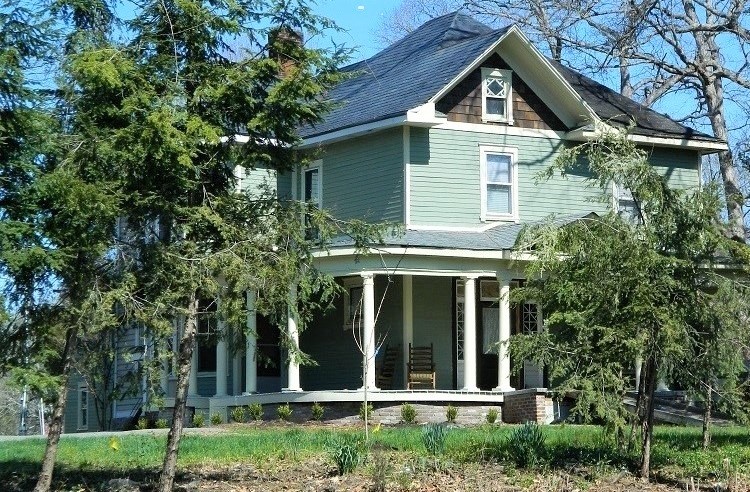Except for the two years he spent treating World War I veterans in a hospital in Pittsburgh, Pennsylvania, Claudius M. Capps was a lifelong resident of Knoxville. The family lived in the Victorian-style house directly across from Greenwood Cemetery at the intersection of Hedgewood and Tazewell Pike for many years. They moved to 406 Biddle Heights in East Knoxville late in life.
Claudius Meade Capps was born in the Clinch River community near Cumberland Gap on April 9, 1863. He graduated from the Tennessee Medical College in 1889, then attended the New York Polyclinic (1896-1898) and the Manhattan Eye and Ear Hospital (1898).

Claudius M. Capps M.D. (1863-1951). An early Knoxville eye, ear, nose and throat specialist, Dr. Capps was also an accomplished poet and composer of many songs, including “The Blue Hills of Tennessee.” (Photos Courtesy of the McClung Historical Collection)
In 1898, Dr. Capps returned to Knoxville and established a practice specializing in diseases of the eye, ear, nose and throat. It was said that he was the first surgeon in Knoxville to perform a mastoid operation, among the most demanding and dangerous surgeries performed at that time. He later limited his practice to the diseases of the eye. In 1925 his office was located in the Fretz Building, Suites 207-208, in downtown Knoxville.
The Tennessee Medical College was founded at Gay and Main Streets in 1889 by a group of stockholder physicians, dentists and attorneys. By 1905 the medical college had become associated with Lincoln Memorial University and was sold to LMU in 1909. In 1912, Dr. Capps became Professor of Ophthalmology and Otology at the college. As with so many private medical schools of that era, grave financial difficulties made it necessary for the school to cease operations in 1914. The buildings were later used for the Knoxville General Hospital.
The doctor is remembered for his interesting everyday conversation style replete with poetic expression and humor. Throughout his adult life he spent much of his spare time writing either poetry or song. He also wrote a historical work on the Cherokee Indian Nation. His published books were: “Indian Legends and Poems” (1932), “Sea Dreams” (1936), and “The Blue and the Gray: An Anthology of Civil War Poetry” (1943).
“The Blue and the Gray” was well recognized and sold many copies. It represented the first anthology of Civil War poems published in 30 years when it was published in 1943. Adhering to the 1940s version of political correctness, he omitted John Greenleaf Whittier’s “Barbara Fritchie” which many Southerners considered an unjustified slur on the chivalry of Gen. Thomas J. “Stonewall” Jackson. The anthology contains 160 poems, including James Russell Lowell’s “Ode Recited at the Harvard Commemoration,” and Father Abram Ryan’s “The Conquered Banner.” Also included are poems by William Cullen Bryant, Whittier, Walt Whitman and Henry Timrod. “The Bivouac of the Dead” and the once familiar and poignant, but now almost forgotten, “Little Giffen of Tennessee” were also included.
Little Giffen of Tennessee was only 16 years old and already in his 18th battle at The Battle of Shiloh (April 6-7, 1862). One verse of the poem describes his untimely death in the battle:
Word of gloom from the war one day:
“Johnston’s pressed at the front they say!”
Little Giffen was up and away;
A tear—his first—as he bade good-by,
Dimmed the glint of his steel-blue eye.
“I’ll write, if spared!” There was news of the fight:
But none of Giffen—he did not write
Although the doctor had taken music at age 10, his schoolwork and, later, his interest in medicine consumed so much time that he did not begin composing until the late 1920s. He took one of his songs, “Blue Hills of Tennessee,” to U.S. Rep. J. Will Taylor’s office, and the Congressman told him to take it to Miss Elizabeth Simpson, former federal employee who could “sing like no one else could.” Miss Simpson sang the song beautifully and asked the doctor to write another especially for her. He asked, “Where were you born?” She replied, “Kentucky.” He wrote “My Kentucky Rose,” and dedicated it to her. In 1938 it was arranged for the famous Tennessee Theater organist, Billy Barnes, to include the selection in his organ program with Dr. Claudius Capps as honored guest for a movie and a mini-concert.
The “Blue Hills of Tennessee,” written in memory of his mother, sold more than 5,000 copies soon after it went on sale. He later wrote “My Old Tennessee Home,” which he considered a contender for the Tennessee State Song. Unfortunately, other compositions preceded it, and then “The Tennessee Waltz” and “Rocky Top” were published. “My Old Tennessee Home” was never chosen. When asked whether it was difficult writing songs, the doctor replied, “Getting ideas for songs … is the least of (my) worries. It isn’t hard. It comes as natural as eating. I never worry about ideas.”
Dr. Capps married Ollie Beeler (1873-1948) of Union County. During their long and happy marriage, they had four children, Paul, Claude M. (1912-1985), Ethel and Nora (Dewey) George, wife of the Knoxville City Councilman (1936-1937).
After 60 years of marriage, his wife died on April 6, 1948. Dr. Capps followed her in death on August 27, 1951. The Capps family had been members of the Knoxville First Baptist Church since before the turn of the century, more than 50 years. They are buried in Greenwood Cemetery just across from “Oak Forest,” their former home on Tazewell Pike in Beverly.
Jim Tumblin, retired optometrist and active historian, writes a monthly series on Fountain City for KnoxTNToday.com.




